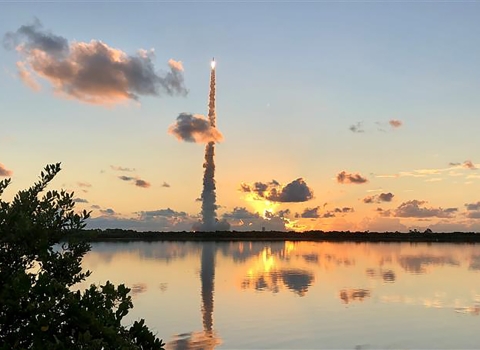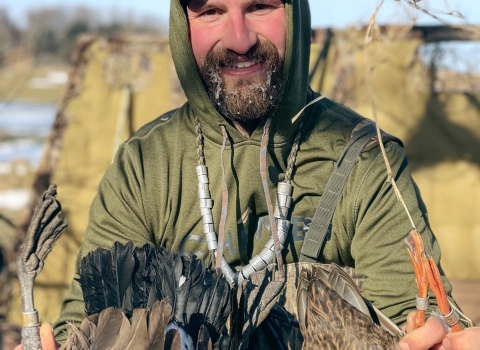The project is partnership between River Partners (a 501(c)3 non-profit) and the U.S. Fish and Wildlife Service (USFWS), San Diego National Wildlife Refuge Complex.
This restoration project will improve habitat quality within the Otay River floodplain by replacing non-native vegetation with structurally diverse, native plants to support a variety of neotropical migratory birds, including several listed species, as well as an array of other native wildlife. The project also performs an ecosystem service - a natural filter for storm water runoff destined for San Diego Bay.
The project has converted 55 acres of weed-infested land with a variety of native trees and shrubs, as well as understory plants and grasses. River Partners’ restoration methods include invasive plant removal, collection and propagation of native plant materials from within the Lower Otay watershed, installation of a drip irrigation system and plant installation. In project years 2 and 3, River Partners manages site irrigation, controls weeds, replants as necessary, monitors growth, provides updates to funders and partners, and conduct outreach to local residents in partnership with USFWS. Local Girl Scout Troop #5912 of San Ysidro has been involved with the Otay Valley Regional Park in the past, and was happy to get involved with this project on the Refuge. The 50-strong troop planted hundreds of plants, and nine of the girls painted an wildlife mural of the Otay River Watershed as a Silver Award Project to deter the habitual graffiti in the area, and educate bikers and walkers of the unique wildlife that live there as they pass through.
This restoration project not only benefits migratory birds, it increases the natural values of the San Diego Bay National Wildlife Refuge. In doing so, more recreational space is available to Refuge visitors as well as the residents of Chula Vista and bikers who utilize the “San Diego Bayshore Bikeway.” Approximately ½ mile of this bike trail runs through the proposed restoration site.
Project Rationale
Riparian systems harbor the highest abundance and diversity of wildlife in California. The Otay River likely once supported an intact bird community consisting of many currently federal and state listed species of special concern. Restoring native riparian riparian
Definition of riparian habitat or riparian areas.
Learn more about riparian habitat within the Otay River watershed will benefit a range of wildlife species including more than 60 species of neotropical migratory birds that depend on Southern California open space for breeding and foraging.
Portions of the Otay River watershed have been ravaged by wildfire, overtaken with invasive species invasive species
An invasive species is any plant or animal that has spread or been introduced into a new area where they are, or could, cause harm to the environment, economy, or human, animal, or plant health. Their unwelcome presence can destroy ecosystems and cost millions of dollars.
Learn more about invasive species , and suffer negative impacts from agricultural activities, urban development, gravel mining, reservoir development, and various infrastructure projects. Eight of the neotropical migratory birds that could benefit from this project have been identified by the USFWS as Birds of Conservation Concern; at least three, including the least Bell’s vireo (Vireo bellii pusillus), are federally listed endangered species. In addition to the significant habitat this project will provide by itself, it is one of several riparian restoration projects planned for the watershed that (when funded and implemented) will provide a significant contribution to the wildlife corridors and habitat values of this river valley.
Multiple regional and international bird conservation efforts identify the Otay Delta as important wildlife habitat. The Partners in Flight North American Landbird Conservation Plan (2004) names the riparian woodland and scrub habitats within the Pacific Avifaunal Biome as critical habitats for migrating birds and recommends restoration and management of these habitats to support native conditions, processes, and species. The Sonoran Joint Venture Bird Conservation Plan (2006) includes a similar recommendation for riparian habitats within coastal California, and identifies San Diego Bay as a focus area in the California Coast and Mountain Region of the Sonoran Joint Venture. The adjacent portion of the San Diego NWR is listed as an Important Bird Area for both resident and breeding species by the American Bird Conservancy.
This restoration is also consistent with objectives of the California Partners in Flight Riparian Bird Conservation Plan (2004), including prioritizing restoration sites for protection and restoration, and increasing the value of restoration projects for bird species.
Project Funders
River Partners’ Otay Delta restoration project at the San Diego Bay NWR is a $1.17 million project funded by the Wildlife Conservation Board, the Natural Resources Agency (through Caltrans), The San Diego Foundation, the National Fish and Wildlife Foundation through Walmart, and the USFWS.
The restoration effort has benefitted from broad community involvement thanks to the San Diego Bay NWR, WiLDCOAST, High Tech High School Chula Vista, and Friends of the Otay Valley Regional Park.


